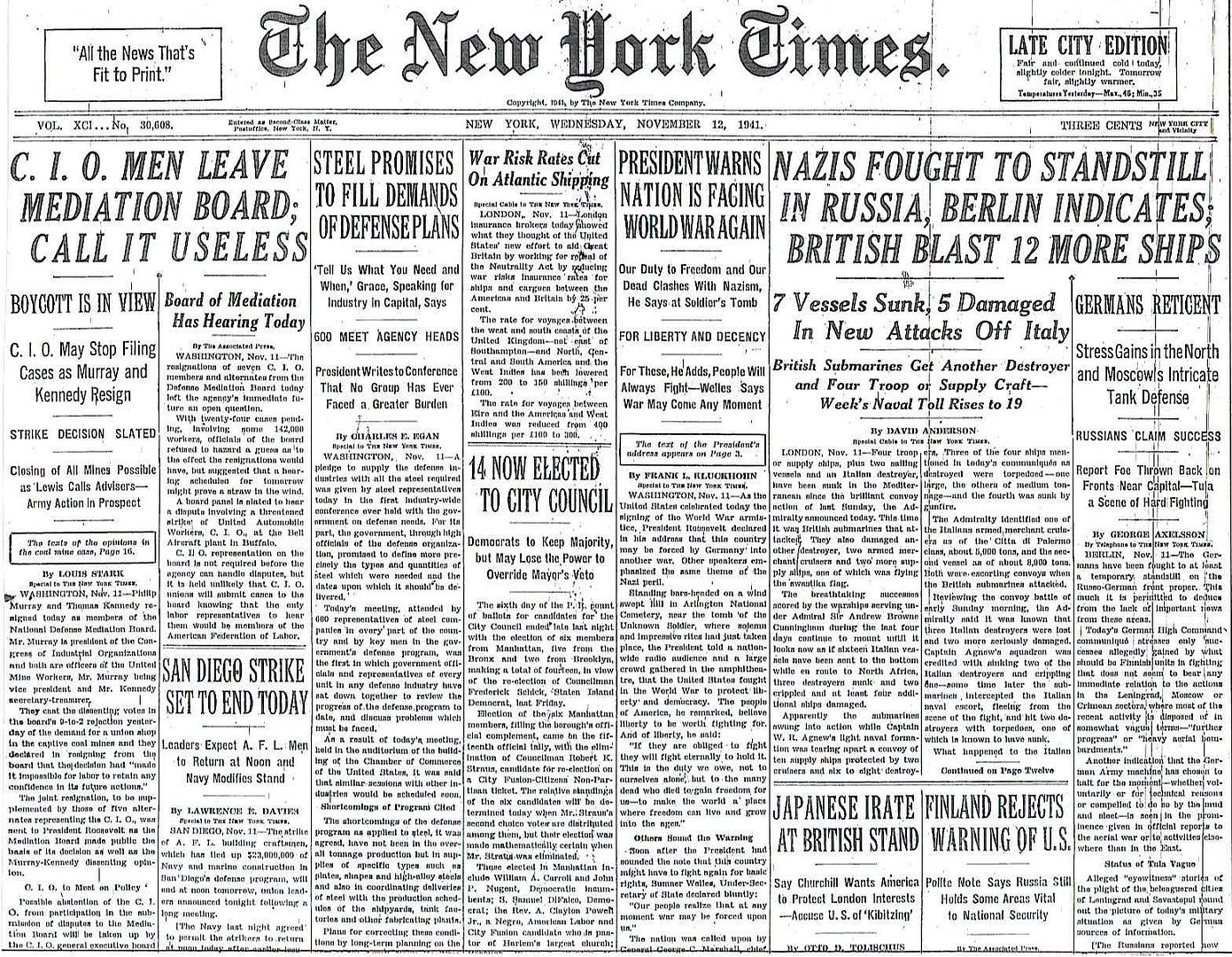
Posted on 11/12/2011 5:54:18 AM PST by Homer_J_Simpson


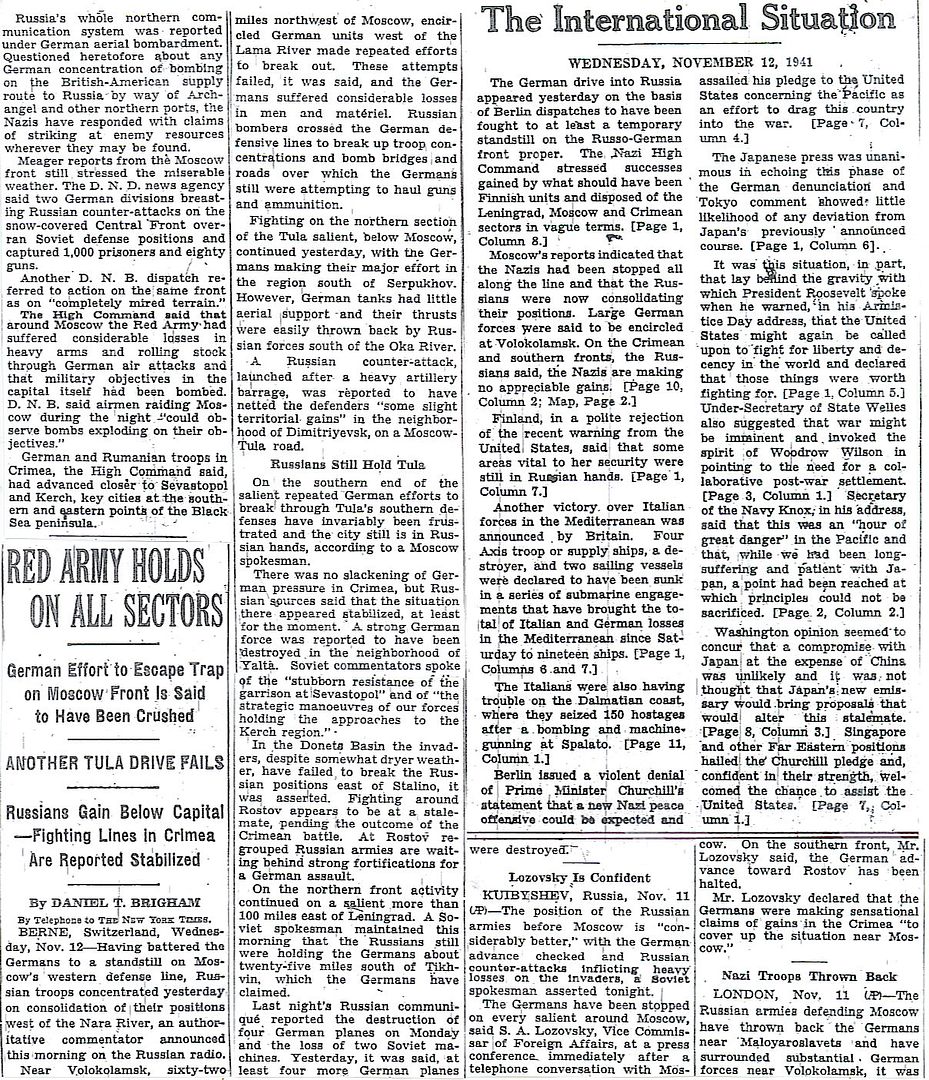
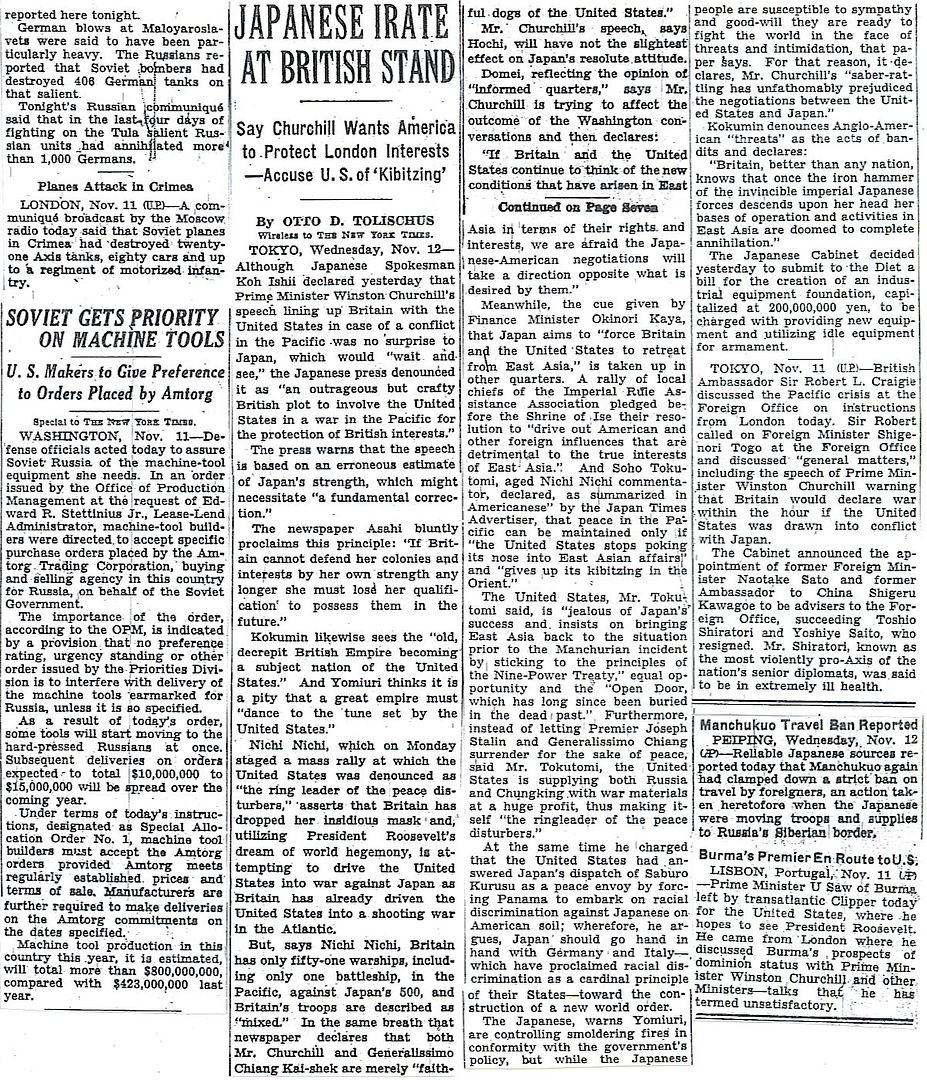
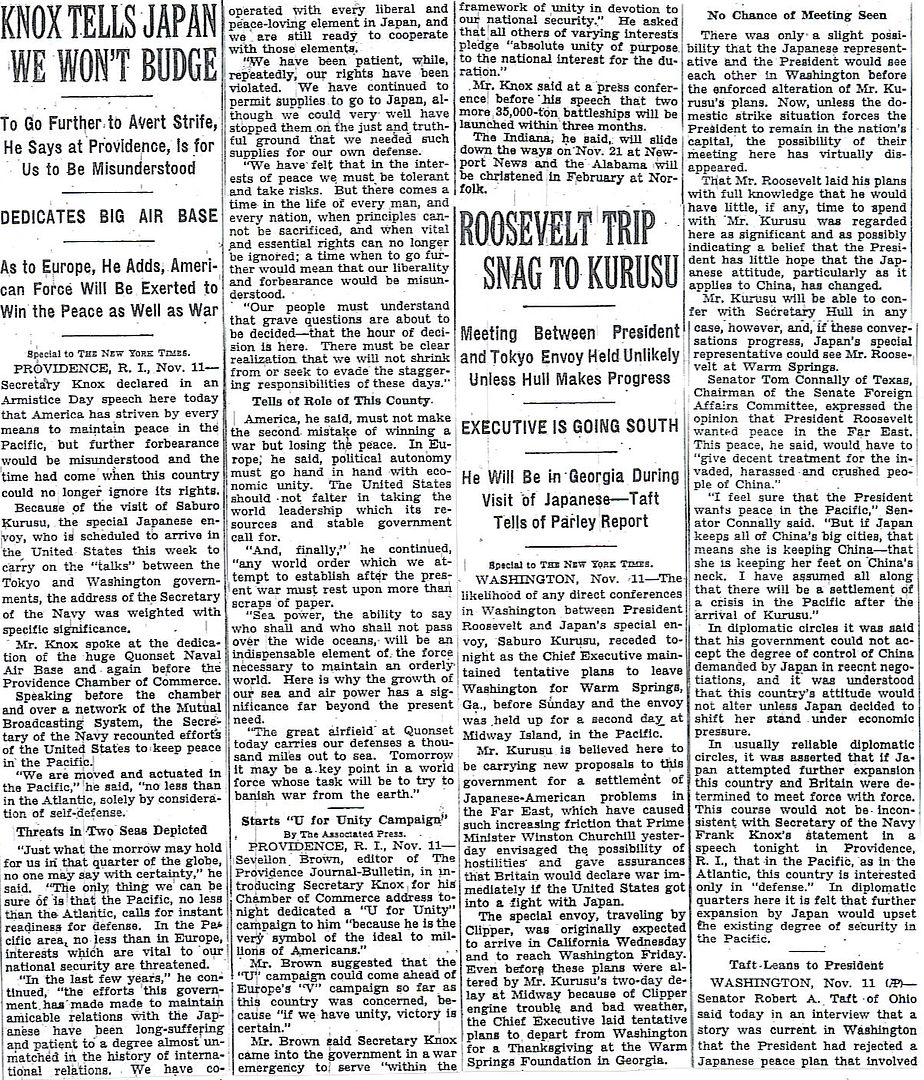
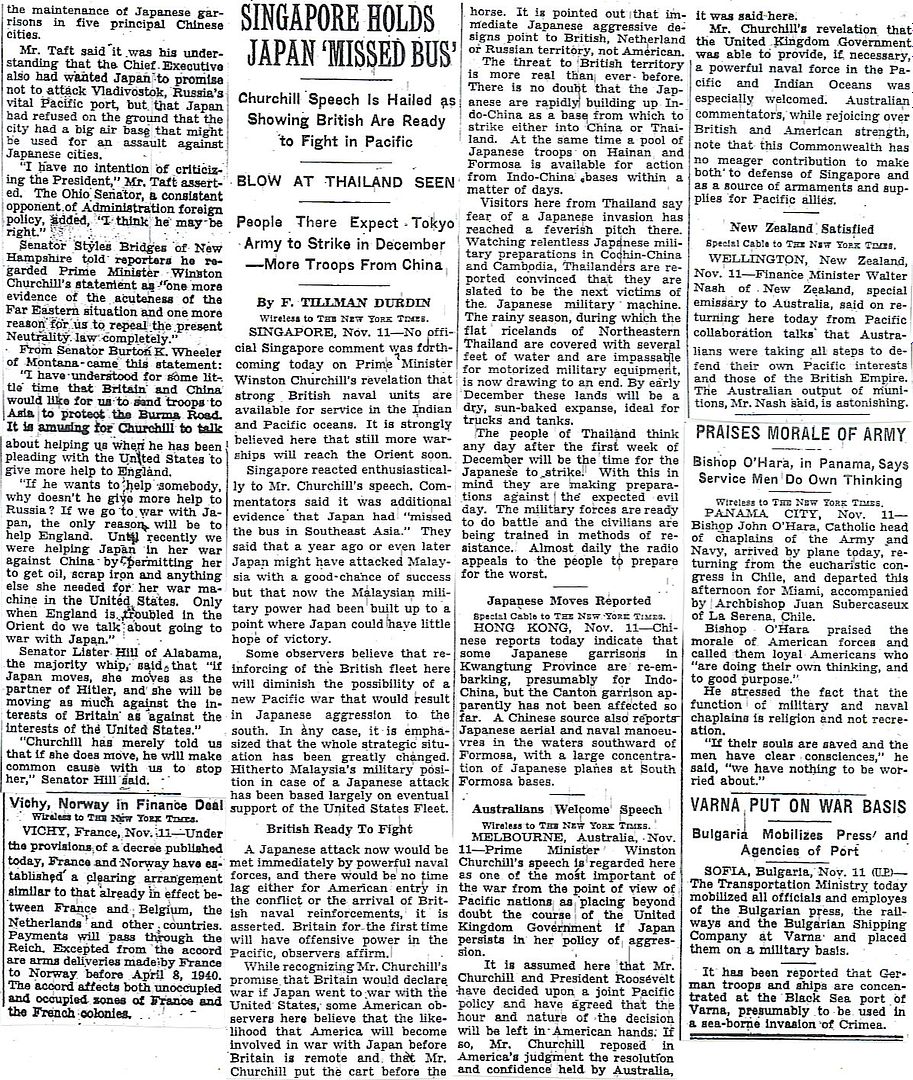
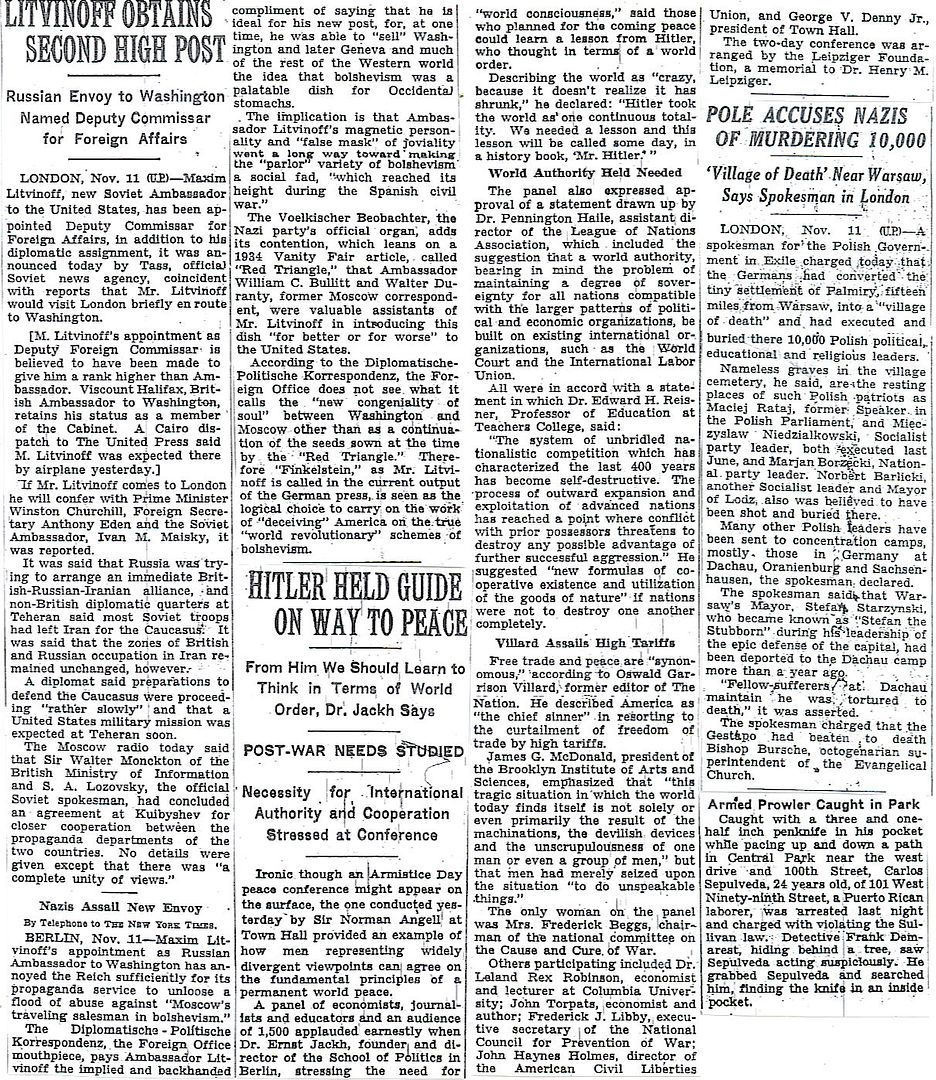
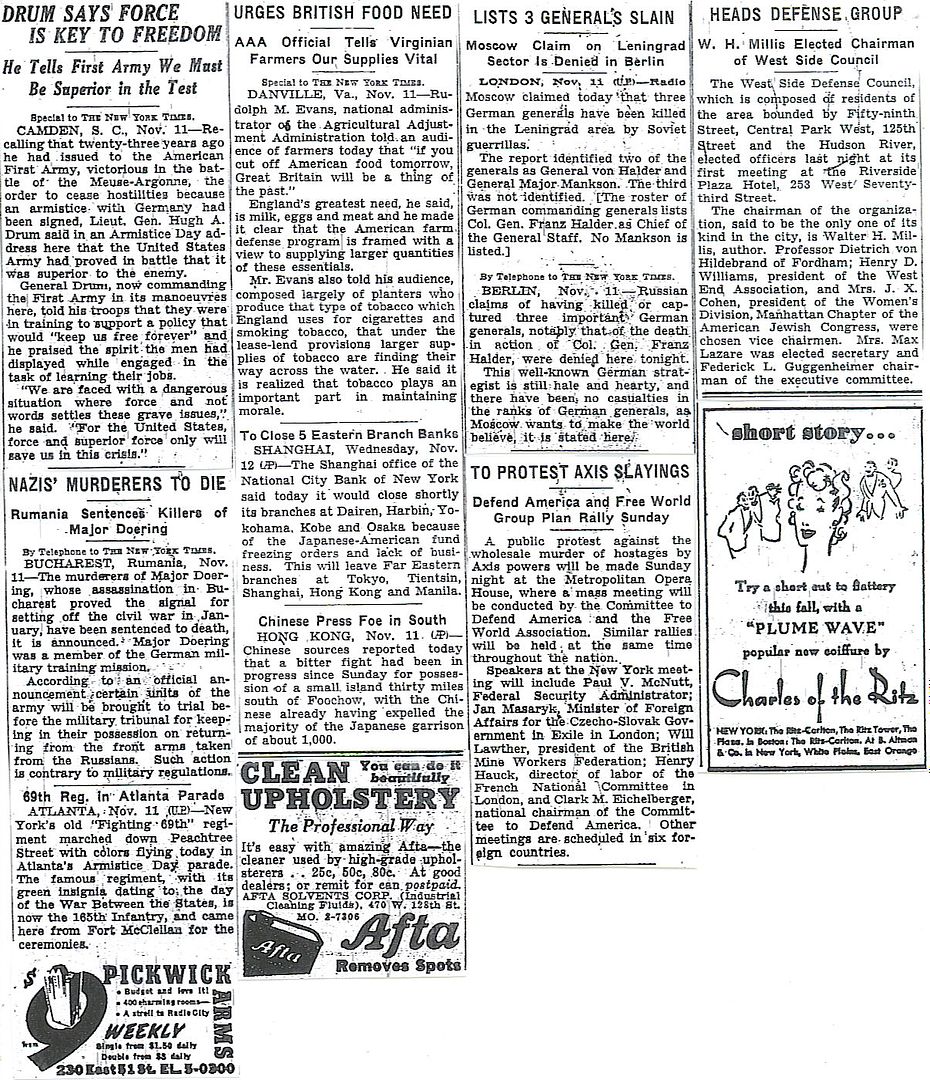

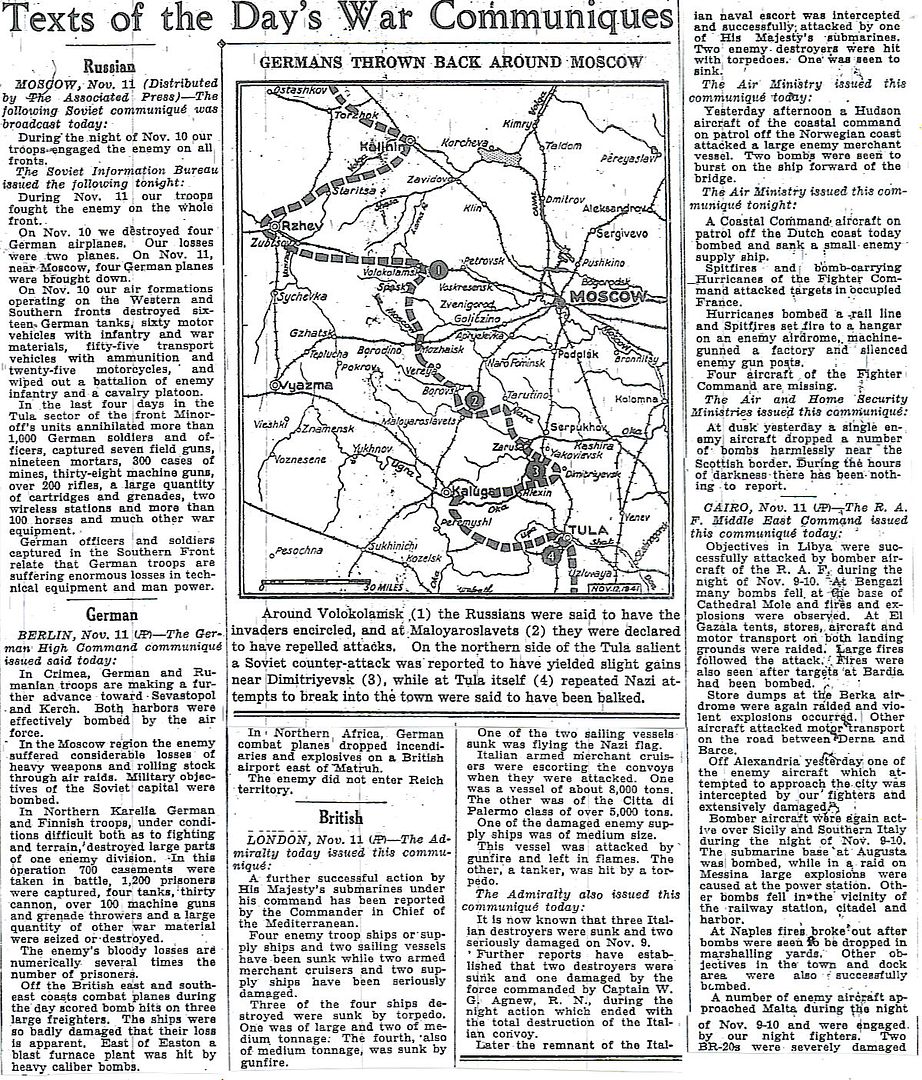
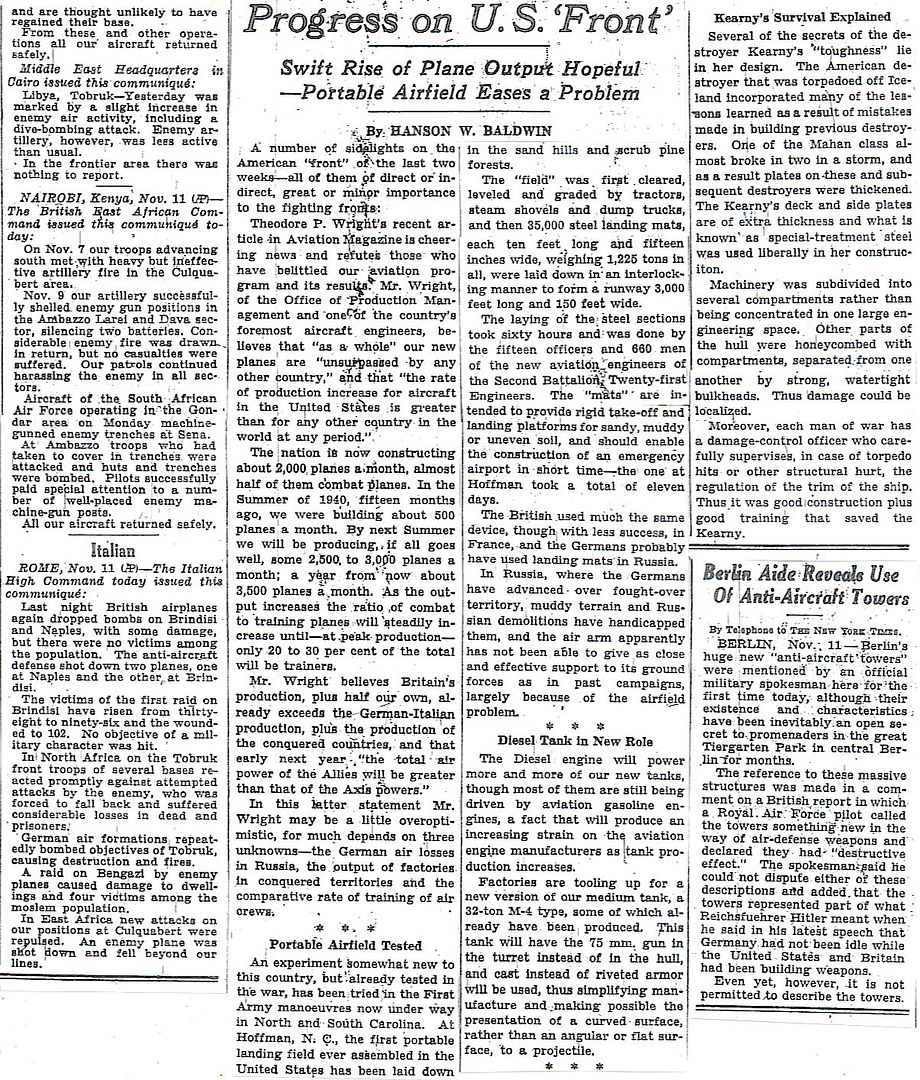
http://www.onwar.com/chrono/1941/nov41/f12nov41.htm
Germans agree on plan of attack
Wednesday, November 12, 1941 www.onwar.com
From Germany... At a conference held at Orsha in the occupied Soviet Union, German field commanders meet to hear General Halder’s (the OKH Chief of the General Staff) plans to continue the attack on Moscow. The plan involves three infantry armies and three panzer groups. Despite some reservations the plan is agreed upon.
In the Mediterranean... The British carriers Argus and Ark Royal bring a further 34 Hurricanes to the island to add to its air force.
http://homepage.ntlworld.com/andrew.etherington/month/thismonth/12.htm
November 12th, 1941
UNITED KINGDOM: Destroyer HMS Ulster laid down. (Dave Shirlaw)
FRANCE: Nimes: General Huntziger, the Vichy war minister, was killed 50 miles north of here today, in a plane accident. He was returning from a mission to North Africa, to consult General Weygand on a possible German bid to use French North Africa.
Though Huntziger signed the armistice with the Germans in June last year, he was a staunch defender of French interests against German encroachment and the strongest opponent of Laval’s efforts to open French ports to Germany.
U.S.S.R.: At Orsha senior German commanders are shown the plans for the continuing attacks on Moscow. Three Panzer groups and three infantry armies will participate.
The Red Army uses its ski troops in combat for the first time in the Great Patriotic War today. (Patrick Holscher)
Germans sink cruiser Chervona Ukraina, the only one lost by Soviets in World War Two. (Dave Shirlaw)
MEDITERRANEAN SEA: U-331 left Salamis with eight members of a special service team on board for the African front in Tobruk. (Dave Shirlaw)
CANADA: Corvette HMCS Ville de Quebec (ex-HMCS Quebec) laid down Quebec City, Province of Quebec.
U.S.A.: Minesweepers USS Pursuit and Requisite laid down. (Dave Shirlaw)
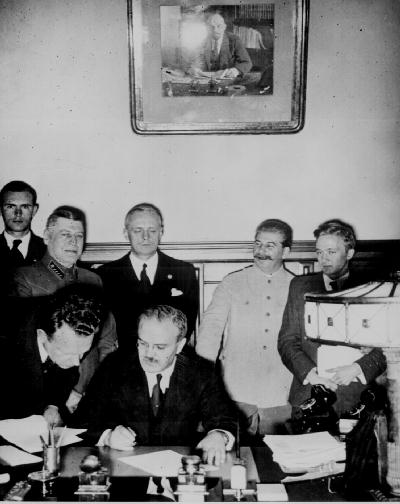
"...at the time of the Nazi-Soviet Pact, the Communists suddenly transformed the 'Anti-Nazi League' into the "Hollywood Peace Forum," calling for American neutrality and using the slogan 'Let's Skip the Next War.'..."
--Ronald Radosh, from his book, Red Star Over Hollywood: The Film Colony's Long Romance With the Left
http://www.capmag.com/article.asp?ID=4251
___________________________________________________
"[Pete] Seeger was antiwar during the period of the Nazi-Soviet Pact; pro-war after the Soviet Union was the ally of the United States; and anti-war during the years of the Cold War and Vietnam." --Ronald Radosh (former communist)
http://www.frontpagemag.com/Articles/Read.aspx?GUID=01133F31-CE9A-40BC-B797-47CBB0023EF4
Less than a month from now,Dec 5th,Marshal Zhukov,unleashes
his Siberians against the Germans.
The news is really heating up in the Far East.....
Soviet historians will go to great lengths to discount how important Lend-Lease was to the Great Patriotic War it fought against the Germans. But the reality is quite different, and today’s report points to one of those critical cogs in the Soviet war efforts wheels. The incredible movement and reestablishment of the Soviet industry across the Urals would never have been able achieve full capacity without the machine tools provided by the United States and Britain.
Part Six- 5 Miles To Moscow
In the mild winter weather of the first few days of the new offensive, Lieutenant-General Veiel's 2nd Panzer Division struck without warning and boldly crossed the Lama river.
Soviet resistance along the waterway was broken immediately and decisively.
The division then bypassed Klin in the south, while LVI Panzer Corps moved against the town from the north-west.
Rumors spread that the first meager consignments of winter clothing had finally arrived at the front-it had,— one greatcoat for each gun crew. One greatcoat!
That was on 19th November. On that same day the weather broke and the thermometer plummeted to 20 degrees below zero Centigrade (-4 Degrees Fahrenheit). Snow fell. Freezing fog formed even in daytime. The severe Russian winter had arrived, earlier than in many previous years, but by no means as exceptionally early as is often claimed.
On 23rd November Lieutenant-Colonel Decker's combat group, moving in advance of the spearheads of V Corps with parts of the reinforced 3rd Panzer Regiment, penetrated into Solnechnogorsk from the west. The 2nd Rifle Brigade under Colonel Rodt attacked the town from the north-west with 304th Rifle Regiment. The strong Russian defenses were overcome and more than two dozen enemy tanks destroyed. The bridges over the canal were secured intact. Things were moving again.
As a result, General Veiel's Viennese 2nd Panzer Division stood 37 miles from Moscow on an excellent road.
On 25th November Colonel Rodt took Peshki, south-east of Solnechnogorsk, another six miles nearer Moscow.
Standing on a hill, the colonel saw through his binoculars three tanks approaching. "What type of tanks are those?" he asked his orderly officer.
"No idea, Herr Oberst," was the reply.
A few rapid commands were given and the first shots were fired. The spearhead of 1st Battalion, 3rd Panzer Regiment, appeared suddenly from behind undulating ground and opened up at the surprised enemy tanks with its 7.5-cm. guns. Two of the tanks were hit; the third withdrew. When Colonel Rodt inspected the wrecks he was much surprised—British Mark III tanks, which could be effectively opposed even with the German 3.7-cm. anti-tank gun.
Russian translations of the original English lettering and instructions were chalked up on the sides of the tank. They were the first items of British aid for Stalin to appear in the fighting line.
The infantry divisions of V Corps were likewise driving along both sides of the great road, southward towards Moscow and south-eastward towards the Moskva-Volga Canal.
They were the 106th, 35th, and 23rd Infantry Divisions. The canal was the last natural obstacle to Moscow's being outflanked in the north. If it was overcome the northern attacking force—Fourth Panzer Group and Third Panzer Army —would have the worst behind them. The Potsdam 23rd Infantry Division headed for the canal via Iksha with 9th Infantry Regiment. The division's other infantry regiment, 67th Infantry Regiment, and the Reconnaissance Battalion 23 were likewise fighting their way to the canal north-east of Krasnaya Polyana. Farther south the reinforced 2nd Rifle Brigade, moving past Krasnaya Polyana, gained Katyushki on 1st December. This village changed hands several times. Patrols of 2nd Company, Panzer Engineers Battalion 38, were advancing in the direction of the railway station of Lobnya. It looked as though the Blitzkrieg was in full swing again.
At first the Russians were confused. And, as always in such a situation, a great many opportunities presented themselves.
One of these is illustrated by the following episode.
Motorcycle patrols of Panzer Engineers Battalion 62—originally operating under 2nd Panzer Division, were moved forward by Hoepner himself on 30th November. They passed swiftly beyond the most forward pickets of 2nd Panzer Division, to strike at the railway station of Lobnya and the area south of it—roaring forward on their machines they were bewildered to discover that Soviet opposition had disappeared completely- so they kept on going along the eerily silent road until they reached Khimki, the small river port of Moscow, five miles from the outskirts of the city.
They spread alarm and panic among the population and raced back again only because their flanks were unprotected. It was these motorcyclists and Corps sappers who probably got closest to Stalin's lair. But units of 106th Infantry Division, attacking on the right of 2nd Panzer, got almost as close to the Kremlin when a combat group of 240th Infantry Regiment, reinforced by a combat detachment of 52nd Anti-aircraft Regiment, reached Lunevo.
Russian sources, even today, relate these events with an air of horror—the same horror that swept the Kremlin during the war when the news came:
"The Germans are at Khimki!"
In the General Staff citadel inside the Kremlin there had in fact been grave dismay ever since 27th November. Stalin was pacing up and down along the great map table, scowling. There was disastrous news from the front: "Enemy forces of the German Third Panzer Army have crossed the Moskva-Volga Canal at Yakhroma, 43 miles north of Moscow, and have established a bridgehead on its eastern bank. There is the danger of a break-through to Moscow from the north." Since there were no further defenses beyond the canal, the words "danger of a break-through from the north" were tantamount to an admission that, unless major enemy forces were prevented from crossing over to the eastern bank, Moscow would be lost.
What had happened?
The battle-hardened LVI Panzer Corps under General Schaal—at the beginning of the campaign Manstein's striking force—had been operating to the left of V Corps with 6th and 7th Panzer Divisions as well as 14th Motorized Infantry Division. On 24th November it had taken Klin, and shortly afterwards Rogachevo; it had pressed forward through the burst seam between the Thirtieth and Sixteenth Soviet Armies as far as the Moskva-Volga Canal, and had immediately established a bridgehead on the far bank.
In a bold stroke Colonel Hasso von Manteuffel seized the canal bridge at Yakhroma with the reinforced 6th Rifle Regiment and units of 25th Panzer Regiment, stormed across the waterway, and dug in for all-round defense of the bridgehead.
A Soviet armored train which appeared on the scene was immediately attacked by a tank company of 25th Panzer Regiment under Lieutenant Ohrloff, an officer decorated with the Knights Cross of the Iron Cross, and quickly destroyed. The Russians, in utter confusion, were taken prisoners, and Moscow's big electric power plant was occupied intact.
Manteuffel had thus gained possession of the most easterly point of the Moscow front, and, in addition to setting up a bridgehead for Third Panzer Army on the eastern bank of the canal, also seized the Kremlin's lightswitch.
But finally, there came a day near the Russian town of Yakhroma. On that afternoon of 27th November, within the short span of two hours, the thermometer plunged to 40 degrees below zero Centigrade(-40 degrees Fahrenheit). Against this Arctic cold the men of Manteuffel's combat group had only their simple balaclava helmets, their short cloth coats, and their much too tight jackboots. In this kind of outfit it was impossible to fight at 40 degrees of frost—even against a weak enemy.
Their unpreparedness for the Russian winter was now to be paid for dearly.
Not only were there no fur jackets and no felt boots—what was even worse, the German High Command did not know, or failed to apply, certain perfectly simple and easily practicable rules of winter warfare. If any proof were needed that this war against Russia had not been carefully prepared over a long period—at least not by the German General Staff—then it is provided by the evidence of total ignorance of the simplest facts of winter warfare. Thus when, after the first snowfalls, the Finns saw that the German troops were still wearing their jackboots with steel nails, they shook their heads in amazement: "Your nailed boots are ideal conductors of the cold—you might just as well walk about in your stocking feet!"
In a lecture to the Moscow Officers' Club towards the end of the war, Marshal Zhukov stated that his respect for the German General Staff had first been shaken when he saw the German prisoners taken during the winter battle. "Officers and men all had closely fitting footwear. And, of course, they had frost-bitten feet. The Germans had overlooked the fact that ever since the eighteenth century the soldiers of the Russian Army had been issued with boots one size too large, so that they could pack them with straw in the winter, or more recently with newspapers, and thus avoid frostbite."
The Russians certainly avoided frostbite. Among the German front-line troops, on the other hand, the incidence of frostbitten feet was as much as 40 per cent, in many divisions during the winter of 1941-42.
But the frost struck not only at the troops' feet. The oil froze in the machines. Carbines, machine pistols, and machine-guns packed up. Tank engines would not start. In these circumstances it is hardly surprising that Manteuffel's combat group was unable to hold the Yakhroma bridgehead, in spite of the defenders' stubborn resistance, when two Soviet brigades, the 28th and 50th Brigades of the Soviet First Striking Army, wearing winter greatcoats and felt boots, attacked them. The Russians' sub-machine-guns peeped out of fur cases, and the locks of their machine-guns were lubricated with winter oil. There were no stoppages or jammed bolts on the Russian side. The Russians were able to lie in the snow, if necessary for hours, to creep up to the German outposts at a suitable moment and silence them. Their infantry was supported by T-34s, whereas all that the 25th Panzer Regiment, 7th Panzer Division, had left were some Skoda Mark III tanks with 3.7-cm. cannons and a few Mark IVs with 7.5-cm. cannons.
Thus, on 29th November, Manteuffel had to relinquish his bridgehead.
He took up covering positions on the western bank of the canal. To the south-west the 6th Panzer Division covered the right wing of LVI Panzer Corps. The Corps' left wing was covered by 14th Infantry Division and 36th Motorized Infantry Division.
The chance of a lightning blow at Moscow from the north had been lost, forever.
Twenty miles south of Yakhroma, on the other hand, the situation took a dramatic turn. South of Rogachevo the XLI Panzer Corps, which had been brought up from Kalinin, was attacking the canal crossings north of Lobnya on the right wing of Third Panzer Army on 1st December. First of all, units of the Potsdam 23rd Infantry Division, surrounded south of Fedorovka, had to be relieved. Farther south, to the northwest of Lobnya, General Veiel's 2nd Panzer Division was threatening Moscow from the north-west. One of its combat groups, under Lieutenant-Colonel Decker, picked its way through blizzard and icy cold as far as Ozeretskoye along the mined road from Rogachevo to Moscow. The village was taken. "All aboard for the Kremlin-on the Red Square route," the outposts wisecracked to each other.
They were standing in the bus-stop shelters on the suburban route to Moscow, beating their arms round their bodies and stamping their feet to keep warm. "Where's that damned bus?" they joked. "Late as usual."
As Second Lieutenant Strauss of the 1st Company Panzerjager Battalion, 38th Division, passed the bus-stop in his car, driving down the road to Gorki, his driver turned to him with a giggle: "Why don't we take the bus, Herr Leutnant? Only a forty-five-minute journey to Comrade Stalin's home."
The sergeant had a somewhat optimistic idea about Soviet buses. The distance to Red Square was, after all, 24 miles.
However, the combat group of the reinforced 2nd Rifle Brigade under Colonel Rodt got much nearer to their objective. On 30th November the brigade's rifle battalions and sappers had taken Krasnaya Polyana against stubborn resistance by Siberian cavalry fighting dismounted, and Moscow workers' militia; they had taken Pushki, and, on the following day, Katyushki. Now Major Reichmann's 2nd Battalion, 304th Rifle Regiment, got as far as Gorki. That was a mere 19 miles to the Kremlin or 12 miles to the outskirts of Moscow. An assault party of Panzer Engineers Battalion 38 actually penetrated as far as the railway station of Lobnya and blew it up in order to prevent its use by Soviet tactical reserves. That was 10 miles from the outskirts of the city and 17 from the Kremlin.
On the road leading from Staritsa via Volokolamsk to Moscow lies the little town of Istra. This town had been chosen as the key-point of Moscow's second line of defense.
It was held by Siberian infantry regiments.
The XL and XLVI Panzer Corps of Fourth Panzer Group had to fight hard for every village and every patch of wood. Inch by inch the advanced formations and combat groups of 5th and 10th Panzer Divisions and the "Reich" SS Motorized Infantry Division struggled forward—over windswept fields and through forests deep in snow. On 23rd November they succeeded in reaching the Istra river and the Istra reservoir.
The reservoir was 11 miles long and, on an average, a mile and a half wide. It fed the Istra river, which was about 100 feet wide and flowed into the Moskva. The ground on the eastern bank of the Istra was high and thickly wooded. The Russians were well established there in favorable positions, with a wide view over the snow-covered fields of the western bank.
Anyone wishing to attack them had to cross the river or the reservoir.
Nevertheless 11th and 5th Panzer Divisions succeeded on 24th and 25th November in crossing the river and the reservoir and forming bridgeheads. Motorcycle Battalion 61 of 11th Panzer Division, led by Major von Usedom, made a daring rush over the ice of the Istra. The Russians opened up at them with artillery. The air was filled with splinters of steel and ice. But the motor-cyclists fought their way across to the far bank and gained a precarious foothold on the frozen ground. The reservoir itself was crossed near Lopatovo, at its narrowest point. There were some anxious minutes as the men headed for the dam of the reservoir. It must have been wired for demolition. What would happen if the dam suddenly burst and gigantic masses of water were released?
But the assault units of 11th Panzer Division were lucky. Their surprise came off.
There was no time for the Russians to press the button. Lieutenant Breitschuh's sappers removed 1100 mines and two tons of high explosive from the reservoir dam.
Farther to the south the crossing of the important Istra river was likewise successfully accomplished. Lieutenant-Colonel von der Chevallerie seized the bridge of Busharovo with the reinforced 86th Rifle Regiment, 10th Panzer Division. The operation was carried out under cover of a thick blizzard. Chevallerie's group was the remnants of the once proud 10th Panzer Division. Now its 7th Panzer Regiment had no more than twenty-eight tanks left, and the 69th and 86th Rifle Regiments had shrunk to four weak rifle battalions of 120 men each. Boehringer's artillery battalion was down to one single tractor and ten guns.
Nevertheless the remnants of 10th Panzer Division fought with spirit.
The enemy put up furious resistance and brought up whatever he could lay his hands on, according to a diary account of one of the men in the action. The self-sacrificing way in which the Russians fought was admirable, but for the time being unavailing, since the attacking units of Army Group Centre continued to nibble their way towards Moscow in spite of all difficulties.
On 26th November, a cold hazy day with a temperature of -4 Degrees Fahrenheit, the combat group of 10th Panzer Division attacked the town of Istra from the north. It was a costly engagement. In the forest fighting which ensued the attackers suffered heavily from the shrapnel of Soviet multiple mortars, but they succeeded in pushing the Soviets—Manchurian units from Khabarovsk—out of the woods and, with a last supreme effort, reaching the northern edge of Istra.
Meanwhile the battalions of the "Reich" SS Infantry Division had come up. The SS Motorcycle Battalion Klingenberg first of all had to burst through a fortified line in the forest immediately west of Istra on the Volokolamsk-Moscow road, held by units of the famous 78th Siberian Rifle Division. The men of that division had a reputation for the fact that they neither took prisoners nor allowed themselves to be taken. In hand-to-hand fighting, with hand-grenades and spades, pillbox after pillbox had to be taken. Klingenberg's motorcyclists fought with spectacular gallantry, and many of the young men of the Waffen SS paid with their lives. When Captain Kandutsch reported on the engagement to his C-in-C, General Stumme, there were tears in his eyes. Many of the eighteen-to-twenty-year-olds who lay dead on the battlefield were barefoot inside their boots. Yet the temperature was -5 degrees below zero Fahrenheit.
Code Name “Typhoon”
Part Seven- Typhoon's Last Gasp
Part Eight- The Siberians Are Coming
After returning from a reconnaissance patrol in the Stalino area of the Donets Basin they make time to bury the body of a comrade. Winter of 1941-42
2 Germans set up a heavy mg to cover a village.
The morning after a Soviet night attack against a German held village NW of Moscow. Nov 1941
Removing casualties from a battlefield after a night attack by Soviets. Nov 1941
Remains of a substantial Soviet patrol after attempting to outflank German positions by infiltrating along a creek bed.
German & Soviet dead along the edge of a trench after close quarter fighting. Soviets infiltrated from the treeline and were only discovered when they triggered mines. Nov 1941
More Soviet casualties from the same battle. These were stopped by MG fire. Nov 1941
Germans used guns such as this 20mm Quad AA gun as infantry weapons. Nov 1941
A German patrol leaves a village for a reconnaissance mission. Temperature is approximately -13F. Nov-Dec 1941
Germans from a listening post found dead after being missing for two days. Nov 1941
Soviet troops killed in a battalion-sized night attack on open German positions west of Volokalamsk. German troops survey the battlefield for weapons, winter clothing and especially boots. Nov 1941
German troops during the vicious fighting that took place in the outskirts of Tula in Oct 1941
German relief troops somewhere north of the Moscow highway attempting to locate their division. Nov 1941
German cemetery somewhere in the Moscow area
Panzer troops on alert for a Soviet attack. Dec-Jan 1941-42
I get a feeling the Red Army is about to land a solid blow.
great pics.
The machinegun in the second photo appears to be an MG 34. The Germans classified it as a light machinegun.
Disclaimer: Opinions posted on Free Republic are those of the individual posters and do not necessarily represent the opinion of Free Republic or its management. All materials posted herein are protected by copyright law and the exemption for fair use of copyrighted works.